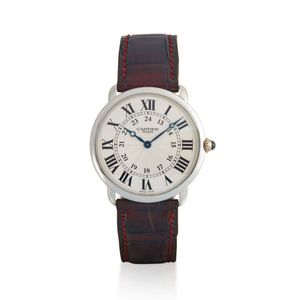Cartier White Gold & Diamond Tonneau Wristwatch
You must be a subscriber, and be logged in to view price and dealer details.
Subscribe Now to view actual auction price for this item
When you subscribe, you have the option of setting the currency in which to display prices to $Au, $US, $NZ or Stg.
- Guilloche - A form of classical decoration consisting of a repeating ornament of interlacing curved bands, sometimes forming circles, and further decorated with rosettes or other flower forms.
The name is derived from the inventor, French engineer Guillot, who invented a mechanical method of inscribing fine repeating patterns on to metallic surfaces.
On enamelled items with guilloche decoration, the surface is firstly engraved with the repeating pattern, and then covered with several layers of enamel, each of which is fired.
Where the item has not been enamelled the form of decoration is usually called "engine turned". - Circa - A Latin term meaning 'about', often used in the antique trade to give an approximate date for the piece, usually considered to be five years on either side of the circa year. Thus, circa 1900 means the piece was made about 1900, probably between 1895 and 1905. The expression is sometimes abbreviated to c.1900.
- Movement - The technical name for the workings of a clock or watch, and does not include the dial or case.
- Bezel - On a clock or watch, the bezel is the metal frame into which the watch or clock glass is fitted. In clocks, the bezel may include a hinge and a flange, in effect a door to the face of the clock. In jewellery the bezel is a band of metal with a projecting lip that holds the gemstone in its setting.
This item has been included into following indexes:
Visually similar items

Cartier. A platinum wristwatch with 24-hour indication no 0007MG 1897E Ronde Louis circa 2003, manual winding movement, 18 jewels, sunburst silvered guilloche dial, painted outer Roman numerals, inner minute track and Arabic numerals for 24-hour indication

A gentleman's gold wristwatch, Bulgari. Automatic. 33 mm. Ref: BB 33 GL. Circular case with white textured dial, applied gold batons and date aperture. Case, dial, movement and deployant clasp signed. 18ct yellow gold. Original brown leather strap.

Rolex Datejust gents wristwatch. Bimetallic gold & stainless steel case. White dial with black painted Roman numeral hours. Black baton hands. Correct Rolex Crown. Excellent condition 35 mm case & recently serviced

Patek Philippe an 18ct gold automatic backwind bracelet watch ref 3569 mvt 1490621 case 2684881 1960s, Cal. 1-350 automatic winding movement, 28 jewels adjusted to heat, cold and 5 positions, stamped with Geneva seal, gyromax balance, textured gilt dial wi
